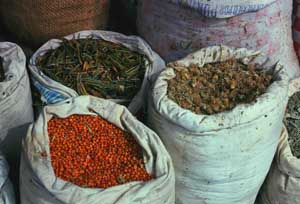|
|
 29 market drugs DHJanzen100268.jpg high resolution
|
|
| The yellowish dried pyrethrin flowers (Asteraceae) in the sack on the right are being sold in a 1974 Mexico City market for household pesticide use (see DHJanzen100267.jpg above), along with other sacks of other secondary compound rich plant parts. Humans have been harvesting and trading/selling/bartering secondary compounds from plants as long as there have been human societies, and probably longer - given that various species of primates have been shown to choose plant parts to eat (and even rub on their bodies in mosquito-ridden rainforest) according to their medicinal/drug properties rather than nutrient traits. While the use of plant secondary compounds for classical medicinal purposes is obvious, it is also likely that essential parts of achieving close-contact civil sociality among highly aggressive, physically dangerous, long-lived large mammals is achieved via the behavior-modifying effects of secondary compounds such as nicotine, morphine (the active ingredient in opiates) and ethanol. Put another way, how do you get 50 highly aggressive adult male humans into the same room for more than a few minutes without someone killing someone? There are various ways, and some involve plant secondary compounds. | ||
back to lecture slides
or skip to: